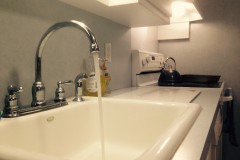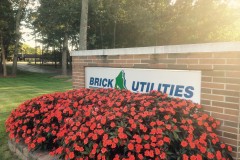In 2011, the Brick Township Municipal Utilities Authority switched the additive in the township’s water supply that was meant to coat copper pipes that could have contained lead-based solder. Now, the agency is switching back to the original chemical.
“The board hired a professional out of Maine,” said James Lacey, executive director of the BTMUA. “She’s suggesting we go back to the old process. We’re gearing up for it now.”
While there is no discernible lead to be found in the township’s water supply itself, testing completed during the summer and fall of 2014 showed higher-than-acceptable lead levels in the water of some homes built between 1982 and 1986 which had copper pipes that were connected with solder that contained lead. The BTMUA advised residents in homes built during those years to run water for 15 to 30 seconds so fresh water would run through the pipes. Lead-based solder was banned by the federal government in 1986.
|
|
The sudden appearance of lead in Brick residents’ water prompted a slew of questions, none asked more commonly than the reasoning as to why it took until 2014 for the lead to appear. State regulations require lead levels to be tested in residential water pipes every three years.
The potential answer may date back to 2011.
The change from the coagulant alum to the coagulant aluminum chlorohydrate, or ACH, was announced at the March 28, 2011 meeting of the BTMUA commissioners. The purpose of the coagulant is to coat pipes so lead will not leach from the solder connections into water that is laying stagnant. Water that lays still in pipes for six hours or more is subject to leaching if not treated.
The switch from alum to ACH was piloted in 2011 for “efficiency benefits,” according to a copy of the minutes from the March 28, 2011 meeting obtained by Brick Shorebeat. By the July 23, 2012 commissioners meeting, the pilot program was fully in place, with the entirety of Brick’s water system being treated by ACH instead of alum. At that meeting, Joseph Maggio, the agency’s director of water quality, told the BTMUA’s commissioners that treatment costs had been reduced by 20 percent since ACH had replaced alum. The cost to treat the township’s water supply dipped from $115.15 per million gallons a year earlier to $92.92. Comparing July 2011 and July 2012, the BTMUA saved about $40,000 on water treatment, the meeting minutes show.
At the same time, the BTMUA eliminated the use of carbon dioxide in its water treatment and began testing a corrosion inhibitor.
“It is all good news and none of it has had any impact on water quality,” Maggio is quoted as saying at the Oct. 22, 2012 commissioners meeting, where the savings had added up to $160,000 with the agency using a quarter of the amount of ACH as compared to alum.
Whether the switch to ACH ultimately led to the detection of lead in some township homes has not been proven, but Lacey said switching back to alum, a less aggressive coagulant, could help the situation.
“It’s going to be seamless, people won’t even notice it,” said Lacey.
The BTMUA’s switch to ACH was allowed under state environmental regulations, said Bob Considine, a spokesman for the state Department of Environmental Protection.
“We permit for the use of different coagulants at surface water treatment plants,” he said, though the state does not track which coagulant particular agencies are using or which additives are being used at a given time to combat the leaching of lead from pipes. It is not known how many water purveyors in New Jersey use ACH and how many use alum.
The DEP is not investigating the BTMUA, Considine said, but keeping in contact with the agency on what steps they are taking to eliminate the problem.
“They are giving us updates and on their approach to address the issue,” said Considine.
Lacey said the consultant the BTMUA hired to look into the lead issue recommended the switch back to alum especially because Brick’s seasonal homes – where water is sometimes left in pipes for weeks or even months at a time – could be especially susceptible if built before 1986 with lead-containing solder. The BTMUA provides water only to the mainland portion of Brick Township; the township’s barrier island portion has water provided by New Jersey American Water Company.
As for the switch itself, Lacey said it takes time for the treatment tanks to be filled, again, with alum. The process will be gradual.
“It’s going to be seamless, people won’t even notice it,” Lacey said.
But even switching back to alum is not guaranteed to cure the issue, he stressed.
“We still think people should continue what they’re doing, take our advice and they’ll be fine.”
~
Editor’s note: Below, we have republished tips provided by the BTMUA for those whose homes were built between 1982 and 1986 and could have lead-containing solder.
According to the MUA, some steps can be taken to reduce the risk, including:
• Run the water to flush out lead. Let the water run from the tap before using it for drinking or cooking any time the water in a faucet has gone unused for more than 6 hours. The longer the water resides in plumbing the more lead it may contain. Flushing the tap means running the cold water faucet for about 1 5- 30 seconds. Although toilet flushing or showering flushes water through a portion of the plumbing system, you still need to flush the water in each faucet before using it for drinking or cooking. Flushing tap water is a simple and inexpensive measure you can take to protect your health. It usually uses less than one gallon of water.
• Use cold water for cooking and preparing baby formula. Do not cook with or drink water from the hot water tap. Hot water can dissolve lead more quickly than cold water. If you need hot water, draw water from the cold tap and then heat it. Do not use water from the hot water tap to make baby formula.
• Do not boil water to remove lead. Boiling water will not reduce lead.
• Look for alternative sources or treatment of water. You may want to consider purchasing bottle d water or a water filter. Be sure the filter is approved to reduce lead or contact NSF International at 1 – 800 – NSF – 8010 or www.nsf.org for information on performance standards for water filters. Be sure to maintain and replace a filter device in accordance with the manufacturer.
• Get your child tested. Contact your local health department or healthcare provider to find out how you can get your child tested for lead if you are concerned about lead exposure. Your family doctor or pediatrician can perform a blood test for lead and provide you with information about the health effects of lead.













